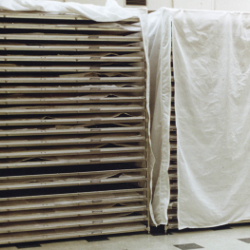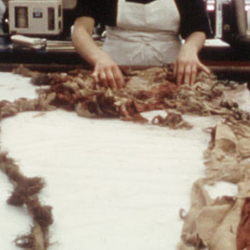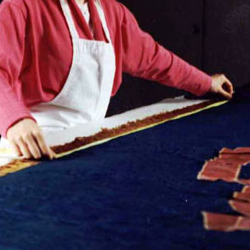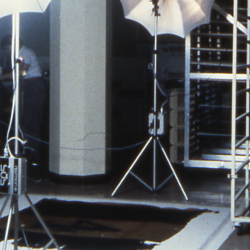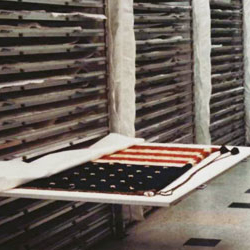 Save the Flags
Save the Flags 
The conditions inside the flag display cases in the Capitol rotunda were far from ideal when the colors were originally installed in 1914. Dust had accumulated on the furled flags, since the sheer net sleeves encasing them offered only minimal protection. Having the flags displayed for a long time in a vertical position while rolled on their staffs placed severe stress on the already fragile fabric.
One of the Capitol Preservation Committee's first endeavors was addressing the need to preserve Pennsylvania's historic battle flags. Growing concern over the flags' deteriorating condition prompted the establishment of the "Save the Flags" project.
The work involved removing the flags from the rotunda so they could be unfurled, photographed, documented, treated, and prepared for long-term storage. The flags were placed in specially designed pallets and transferred to an off site facility located just a few blocks from the Capitol.
The facility includes a conservation laboratory and a long-term storage facility that is temperature and humidity-controlled. To prevent further damage to the flag's fragile silk and paint, each one is stored on an acid-free panel inside a custom-designed stainless steel shelving unit. The staffs from the flags are stored separately in stainless steel pullout units and cross-referenced to the respective flags.
In addition to battle damage, some flags sustained fabric loss as a result of sentimental soldiers who took home pieces of their beloved banners as mementos. Others have only the pole sleeve and pieces of the fringe remaining, however, many are in remarkably good condition. Splitting, powdering, and fragmenting of the silk fabric is attributable to decades of improper environmental conditions, and the natural deterioration of the material.
Generally, treatment of the flags was limited to removing the staff, realigning the distorted silk, vacuuming the particles of soil from the surface of the flag, and collecting the organic debris entangled in the fringe. Flags with severely distorted painted designs were placed in a humidification chamber to relax the fabric, thereby reducing the risk of cracking and splitting of the paint and silk. Saturated salt solutions were used to raise the humidity inside the chamber and maintain an appropriate level.
The humidity level was carefully monitored to safeguard against mold and mildew growth. As the paint became more pliable at 75-80 percent relative humidity, varying weights of glass plates were used to gently release the distortions. This treatment was very successful and produced some dramatic improvements in paint condition.
Documentation was also an important component of the project. Comprehensive written and photographic documentation of each flag and their associated artifacts (staffs, cords, tassels, etc.) are kept on file. This information includes photographs, measurements, and descriptions of condition, design, and construction elements.
In addition, the physical and historical documentation gathered during the conservation project was published in Advance the Colors: Pennsylvania Civil War Battle Flags. Published by the Committee in 1992, this two-volume set was completed by noted military historian, Dr. Richard Sauers. It contains histories on each of Pennsylvania's 215 Civil War regiments, photographs of each battle flag, and numerous appendices. The Committee has also implemented an online searchable database of the collection.
Today the conserved flags remain protected from light, dust, fluctuating temperature and humidity, and also excessive handling. The conservation and storage facility is designed to maintain a stable environment, while accommodating visitors who request to view the public collection. The storage facility is a unique resource for the public by providing supervised access to the flags.
The Capitol Preservation Committee is honored to take part in preserving these historic artifacts for future generations and to serve as custodian of these valuable state treasures.


